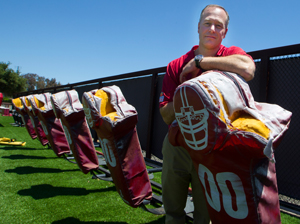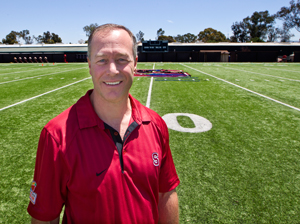June 10, 2013 - By Elizabeth Devitt

Jason Dragoo credits injury prevention programs developed by Stanford Sports Medicine and strength and conditioning specialists at the university with helping to keep Stanford's elite athletes in the game.
It's said that experience is the best teacher. In the case of Jason Dragoo, MD, an orthopaedic surgeon at Stanford who specializes in knee injuries, experience may also make the best healer.
During his college football career as a defensive safety, Dragoo endured many injuries. In the end, he spent as much time in doctors' offices as he did on the playing field. "It really helps for sports medicine physicians to have experienced injuries themselves," he said. "I understand how long it takes each of these athletes to get where they are, whether it's an NCAA competitor, an Olympic hopeful or a professional athlete. It takes years of commitment and effort to get to their skill level, so if I can help them achieve their goals without injury, it's very satisfying to me."
Dragoo joined the faculty in 2005 and is an associate professor in the Department of Orthopaedic Surgery. He divides his time between clinical work, the surgery suite, stem cell research, the Human Performance Lab and the care of Stanford athletes. He also has served as head physician of Stanford's football program for the past six years. He credits the injury prevention programs developed by Stanford Sports Medicine and strength and conditioning specialists at Stanford with keeping elite athletes playing on all the university's sports teams.
For 18 consecutive years, Stanford University has won the Division I Learfield Sports Directors' Cup award, given annually to the best overall intercollegiate athletic program in the country. The football program's recent rise from middle of the Pac-12 to national powerhouse has also contributed to Stanford's ongoing success.
"Earning those accolades takes talented athletes and great coaches. But you can't win if you can't keep your players in the game," Dragoo said. "Maintaining injury-free athletes isn't easy. For example, a whopping one in 10 college-age females will damage their knee ligaments sometime during their four-year NCAA career. Those are staggering statistics. We definitely need to address this problem."
For the past decade, Dragoo has spent part of his research time studying these knee injuries. His results are published in numerous peer-reviewed journals, including the American Journal of Sports Medicine, the Journal of Orthopaedic Research, Sports Medicine and the Journal of Bone and Joint Surgery.
"We've identified a hormone in some women that appears to make them more at risk," Dragoo said. "That hormone, called relaxin, dissolves ligaments. A ligament-loosening agent can be a good thing during childbirth when the pelvis needs to widen to accommodate a baby. It's not so great when there's no baby on the way and other important ligaments are weakened."

During his college football career as a defensive safety, Dragoo endured many injuries. "It really helps for sports medicine physicians to have experienced injuries themselves," he said.
Dragoo's research confirmed the presence of relaxin receptors on the anterior cruciate ligament and showed that relaxin activated those receptors. It also has shown that intercollegiate female athletes with ACL tears had higher levels of relaxin in their blood, which appeared to increase their risk for ligament rupture.
"We also know the concentration of relaxin in the blood that puts women at risk," Dragoo said. The next step will be creating a blood test that accurately identifies at-risk female athletes, as well as developing a safe and effective medication to counteract the effects of the hormone on the knee ligaments while women are pursuing athletics.
Currently, Stanford athletes are learning to protect themselves from injury through physical training programs that teach proper body mechanics. Dragoo found most existing programs were too easy for elite sports competitors. "So we created the Elite Athlete ACL Prevention program where we push athletes to the edge of being in control," he said. "We create unstable surfaces — such as soaking wet playing fields or basketball courts made slippery by wearing socks — and ask them to perform specific maneuvers. If they aren't in the mechanically appropriate position to do so, their feet will slide out from under them."
With continued training, the athletes learn safer biomechanical movement patterns that, ideally, become second nature during competition.
The elite program started in 2011 for several Stanford sports teams. This year, the women's soccer team is participating. "Although it's early in the implementation period, there has already been a marked decrease in knee ligament injuries," Dragoo said.
The third approach in the Stanford Sports Medicine injury prevention plan is SmartBrace technology. "It's an entirely different strategy compared to current knee braces," Dragoo said. Traditional braces don't prevent many types of injuries because they can't effectively stabilize the knee joint in all directions. So he created a new brace in collaboration with a prosthetics bracing specialist and Stanford's departments of electrical and mechanical engineering.
The SmartBrace senses an athlete's movements and provides instant information through built-in computerized feedback devices. "There are certain movement patterns that can make them more susceptible to ligament tears," Dragoo said.
The brace identifies these patterns and gives "haptic feedback" — it vibrates in response to the wrong type of motion. If the wrong movement pattern is repeated, the brace sensors buzz again. So an athlete gets constant, real-time reinforcement to retrain themselves to move correctly. "I really believe this brace is going to change the ballgame," he said.
The next step is to test the beta version of the brace. "We need to make sure the brace accurately assesses movement — that it will identify at-risk movements and lead to a change in the athlete's body mechanics," Dragoo said.
Athletes outside Stanford also benefit from Dragoo's expertise. He's a team physician for the U.S. Olympic Committee and the U.S. Ski Team.
Despite running a schedule that would make an endurance athlete weary, Dragoo makes certain he saves time to spend with his family. "That's the most precious time for me," he said. Fortunately, his family also loves Stanford sports. Dragoo said his 4-year-old and 7-year-old have never missed a home football game. "They know all the players by name," he said. "It's a good way for them to grow up. They see football as fun and college as a normal part of their future."
Elizabeth Devitt is a former science-writing intern in the medical school's Office of Communication & Public Affairs.
About Stanford Medicine
Stanford Medicine is an integrated academic health system comprising the Stanford School of Medicine and adult and pediatric health care delivery systems. Together, they harness the full potential of biomedicine through collaborative research, education and clinical care for patients. For more information, please visit med.stanford.edu.